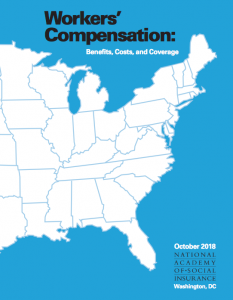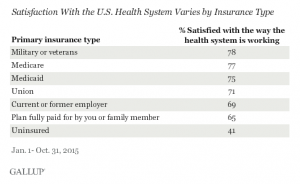My post last week about the (minor) impact of rideshare services on work comp elicited responses from a couple of transportation companies, as well as one anonymous reader who wanted to talk about OneCall’s program (more on that below).
Full disclosure – a few years ago I was among those asserting rideshare companies would disrupt work comp transportation. I’m a lot smarter now (well, perhaps not smarter, just able to see why I was wrong)
Jim Nygren of HOMELINK sent in a detailed comment, which led to a rather extensive back-and-forth email conversation (I disagreed with some of his assertions, and wanted to have a conversation instead of putting up the comment and responding). As readers know, I’m happy to get comments and corrections, but not enthusiastic about marketing masquerading as comments or contributions.
The Jim and Joe conversation was professional, courteous, and perhaps a bit frustrating for both parties. After wrestling with the specifics of our conversation, I decided to post it here. I don’t have any business dealings with HOMELINK; I’ve heard mostly good things about the company, I do like that it is employee owned. I also appreciate the work that HOMELINK has done in an effort to use rideshare services; they’ve clearly spent a lot of time and resource on this.
Here’s the conversation (“Jim” denotes his statements, rest should be self-explanatory)
Jim – Appreciate your post and perspective as always. There are some materially inaccurate comments/assumptions made that need to be addressed, my comments below. The most important thing to know is Rideshare is NOT an exclusive option, if properly implemented it is a tool within a complete transportation solution.
Joe response to Jim comment – I never said or implied rideshare would be an “exclusive option”.
From the original post –
Here’s why I don’t think they’ll replace work comp-specific transportation companies.
This is not to say L/U (Lyft/Uber) won’t be part of the answer – I’m just suggesting that “part” may be pretty defined and not nearly as big as we may have thought a while back.
Jim – My comments come from the perspective of the company I work for, HOMELINK, which began offering Rideshare as a solution in 2015. I look forward to your feedback.
(Jim then quoted text from my original post, with his comment below each quote; here I’ve denoted that text from my original post as “Joe’s original post”) –
Joe’s original post – The big one – being late for or missing an IME is really, really expensive – the payer has to pay the IME doc the $1000 – $2000 anyway, rescheduling an IME incurs more indemnity, attorney, and other expense, and it makes adjusters nuts. The same is true for PT or other medical treatment – although not quite as bad.
Jim’s comment – Rideshare programs are a great solution for just this point. The transparencies provided from real time monitoring of rides allows immediate rescheduling if an adverse issue arises.
Joe response to Jim comment – This may still lead to delays in getting the patient to the IME – unless L/U informs you with sufficient time to reschedule – which is likely much more than 5 minutes – I still don’t see how this solves the issue.
Joe’s original post –
WC patients don’t all have smartphones, so figuring out which patients can access L/U is a necessary first step
Jim’s comment – The benefit of this program is the patient does not utilize commercial applications. The coordination and monitoring of rides are done through the vendor, such as HOMELINK.
Joe’s original post – L/U drivers wait a maximum of 5 minutes – this doesn’t work for patients
Jim’s comment – Through HOMELINK’s processes, every patient is qualified before the coordination of the ride. Patients with specific needs or limiting diagnoses are coordinated with transports meeting their exact needs.
Joe response to Jim comment – And L/U aren’t able to accommodate most of these patients, supporting my assertion.
Joe’s original post –
L/U drivers aren’t going to go up to the patient’s door and help them get into the vehicle
Jim’s comment – As mentioned before, these patients would undergo our initial Rideshare assessment and coordinated with transports meeting their exact needs.
Joe response to Jim comment – And L/U aren’t able to accommodate most of these patients, supporting my assertion.
Joe’s original post –
L/U drivers’ vehicles typically aren’t accessible for patients with limited physical ability
Jim’s comment – This would be vetted in the assessment process as outlined above.
Joe response to Jim comment – And L/U aren’t able to accommodate most of these patients, supporting my assertion.
Joe’s original post –
Some WC patients aren’t native English speakers, and may require drivers to speak their language
Jim’s comment – This would be vetted in the assessment process as outlined above.
Joe response to Jim comment – And L/U aren’t able to accommodate most of these patients, supporting my assertion.
Joe’s original post –
If you try to schedule a pickup for a time in the future, L/U typically don’t reach out to drivers until a few minutes before that pickup time – which may well not work for patients in remote areas
Jim’s comment – Since HOMELINK coordinates the referral, these necessary communications all occur within our patient care teams.
Joe response to Jim comment – This doesn’t refute my core assertion – there’s still a 5 minute rule.
Joe’s original post –
which brings us to location – L/U work really well in metro areas, and not so much in more rural/suburban settings. So, schedulers may find L/U doesn’t have available drivers
•im’s comment – Rideshare and traditional transportation are not mutually exclusive, Rideshare is a cost savings tool to be used by payers when the situation allows. In this example, if Rideshare did not have adequate coverage a traditional transport would be coordinated.
Joe response to Jim comment – never said rideshare and traditional WC transport were “mutually exclusive” – far from it.
Joe’s original post –
you can’t talk to a person at L/U – ever. Many WC transportation services involve a three-way call between the scheduler, driver, and patient; this is just not going to happen with the ride-sharing services.
Jim’s comment – Our relationship and developed workflows allow our patient care coordinates to have open communications with the driver.
Joe response to Jim comment – This doesn’t refute my assumption – are these calls three way ?
Joe’s original post –
Finally, while the dollars are significant in WC, they really don’t amount to that much compared to other opportunities in Medicaid and Medicare. If you’re L/U, you’re going to focus on those payers and ignore WC.
Jim comment – If you’re looking at Rideshare organizations making a direct play with WC you are correct. However, relationships established in this space with companies such as HOMELINK have allowed for payers to capitalize on substantial savings. We have shown comparative savings (Rideshare vs. traditional transportation) approaching up to 40%. This is not an exclusive tool in a transportation portfolio, it is another innovative approach to improve patient experience and optimize savings. Since our rollout in 2015, we have seen Rideshare utilization becoming a larger percentage of our partner’s transportation mix.
Joe response to Jim comment – I asked what percentage of rides are rideshare, Jim responded it is “in the double digits” but would not go beyond that. Thus, it’s not possible to determine if this “savings” is meaningful or not. “approaching up to” is marketing-speak – what is the actual percentage saved for what percentage of rides?
The net – HOMELINK is clearly trying to make the best possible use of rideshare, and kudos to the company for it’s efforts. Much of what they’ve done operationally is to deal with the very real challenges inherent in the L/U business model – a model that is NOT going to change to serve a very tiny market. I’m still waiting to see much of an impact – for reasons I note a couple of paragraphs below.
Re my correspondence with the anonymous commenter re OneCall; s/he made several assertions about OCCM’s use of rideshare. However, I emailed s/he back to ask how s/he knew this, and whether s/he is a OCCM person or customer, and never heard back. (note – the commenter is from Jacksonville, FL, which, perhaps coincidentally, is OCCM’s home town). I’m happy to hear from OCCM, as I noted in the post, or from OCCM’s transportation customers, but readers do need to know who you are to properly understand your statements.
Takeaway – Absent any credible data, it is not possible to quantify the impact of rideshare on work comp transportation. Therefore, we’re stuck with assumptions, albeit ones based on experience.
More important takeaway – There have been any number of “innovations” coming into work comp from outside the industry; models based on what works in group health or Medicare, or efforts to adapt technology and business processes to “fix” problems inherent in workers’ comp.
Most have not worked, or if they have, the impact has been minimal. There are a bunch of reasons for this:
- Every state is different, thus vendors must adapt their tools/approaches/business models to fit 51 different sets of requirements.
- Work comp is tiny and getting tinier – It accounts for 1.25% of total US medical spend, and claim counts continue to decline. Thus the payoff for the investment needed to adapt technology/programs/approaches can be vanishingly small – or even negative – in states that have relatively low work comp spend.
- But (most) vendors must be able to serve customers everywhere – so you are going to lose money in many states and hope you make your profits in the handful of big ones with a lot of comp exposure – California, New York, New Jersey, Texas, Pennsylvania, Illinois, etc.
What does this mean for you?
Innovation in comp will mostly come from inside comp.






